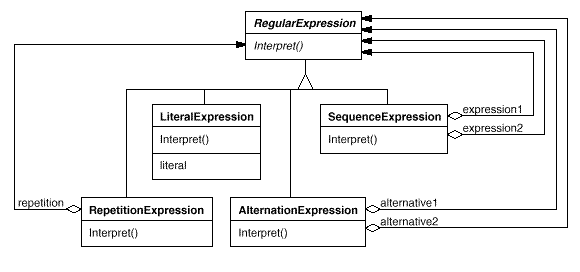If a particular problem occurs often, it might be worthwhile to express instances of the problem as sentences in a simple language, and then build an interpreter that solves the problem by interpreting these sentences. Searching for strings that match a pattern is a common problem. Regular expressions are a standard language for specifying patterns of strings. Rather than building custom algorithms to match each pattern against strings, search algorithms could interpret a regular expression that specifies a set of strings to match.
The Interpreter pattern describes how to define a grammar for simple languages, represent sentences in the language, and interpret these sentences. The pattern describes how to define a grammar for regular expressions, represent a particular regular expression, and how to interpret that regular expression. Suppose the following grammar defines the regular expressions:
expression ::= literal | alternation | sequence | repetition |
'(' expression ')'
alternation ::= expression '|' expression
sequence ::= expression '&' expression
repetition ::= expression '*'
literal ::= 'a' | 'b' | 'c' | ... { 'a' | 'b' | 'c' | ... }*
The symbol expression is the start symbol, and literal is a terminal symbol defining simple words. The Interpreter pattern uses a class to represent each grammar rule. Symbols on the right-hand side of the rule are instance variables of these classes. The grammar above is represented by five classes: an abstract class RegularExpression and its four subclasses LiteralExpression, AlternationExpression, SequenceExpression, and RepetitionExpression. The last three classes define variables that hold subexpressions.

